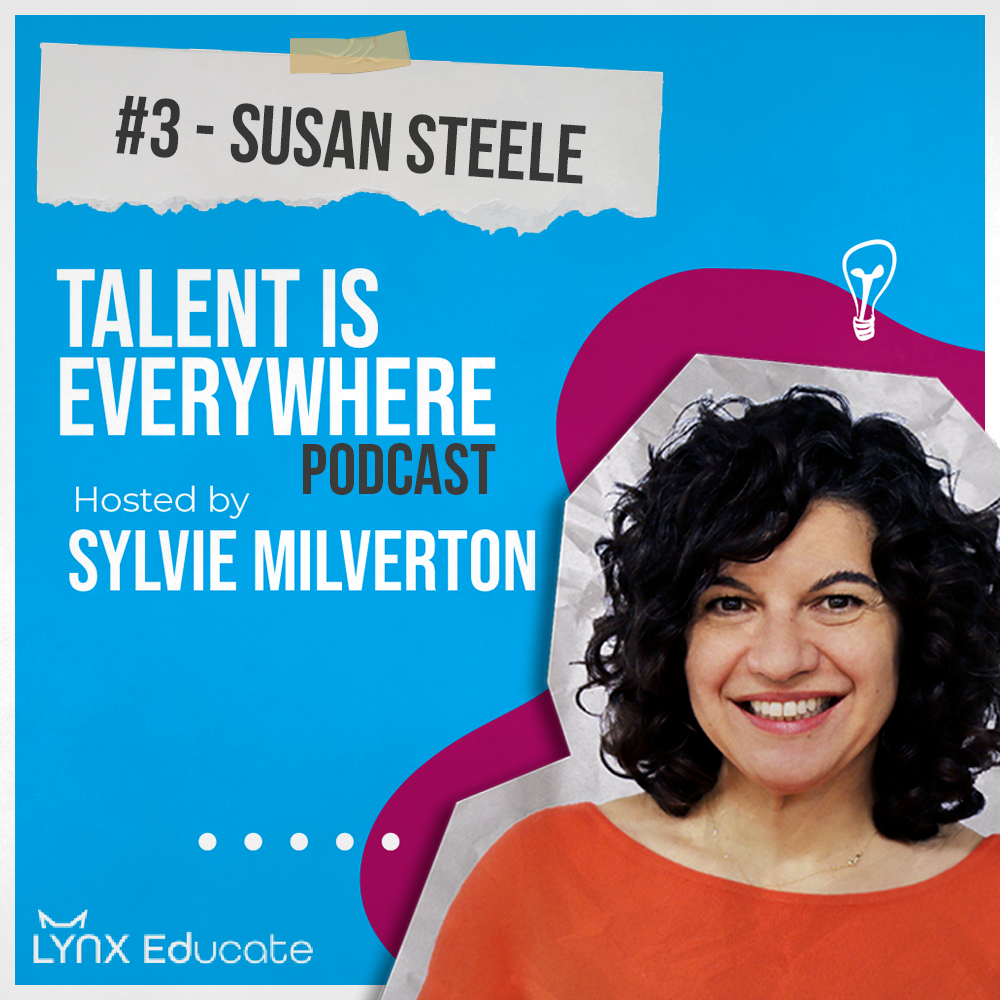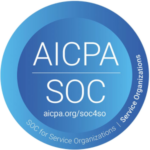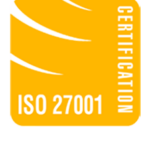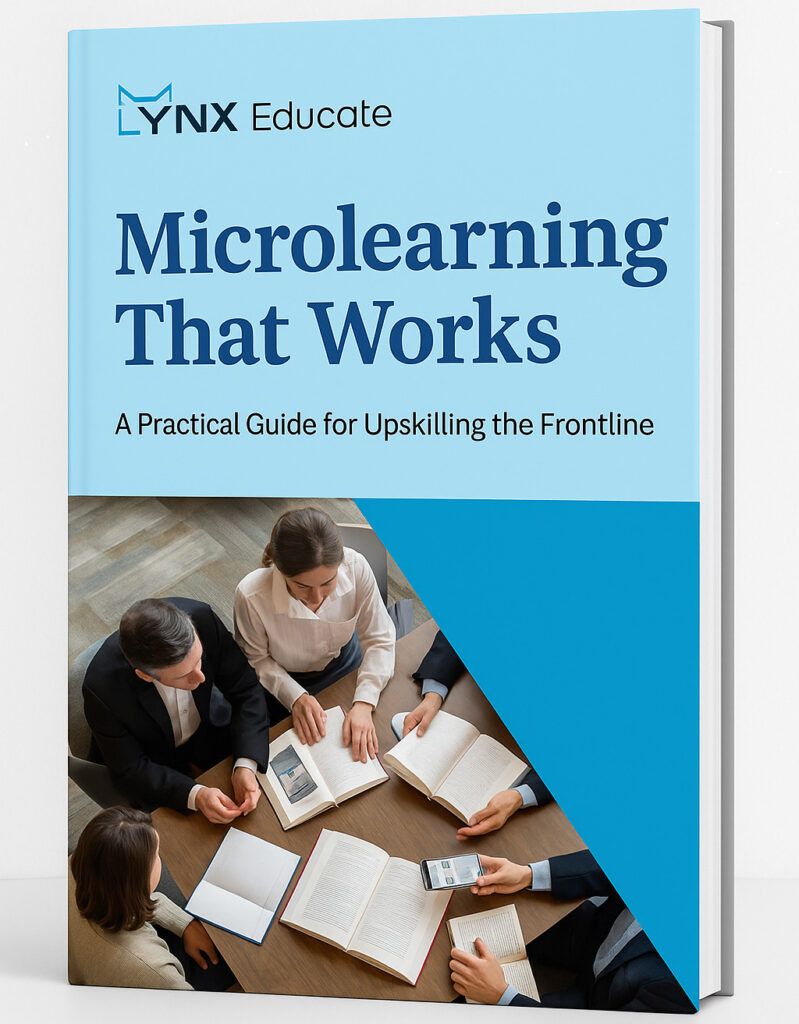#3: Susan Steele - Season 1, Episode 3 - Talent is Everywhere!
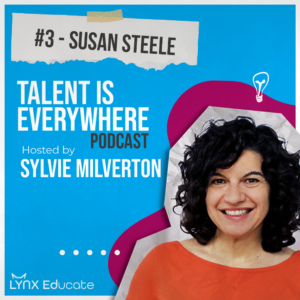
About the Episode:
In this episode, Susan Steele, Chief People Officer at Ebiquity, shares her expertise in managing a large-scale business transformation. From addressing fears among the leadership team to skill development strategies and technology integration, Susan offers practical insights into navigating change successfully.
Talent is Everywhere is a podcast for people leaders who are passionate about the power of education.
We explore ideas on how to keep talent and how to develop talent in order to create the virtuous circle that builds strong businesses.
We’ll interview leaders to hear their experiences of how they invested in people.
Transcript
Susan:
And the assumption was that what an individual is doing today is probably what they were good at doing and ultimately what they enjoyed doing.
Sylvie:
Hi, I’m Sylvie Milverton, CEO of Lynx Educate. This is “Talent is Everywhere”. We’re here to talk about how to keep talent and how to develop talent in order to build a strong business. We’ll interview leaders to hear their best experiences of how they invested in people.
Hi, Susan. Very nice to have you on our podcast. Welcome. You’ve had a nice, long career working in senior HR roles at a lot of big companies like Deloitte and IBM, and then also some smaller companies like Ocean Technologies and Ebiquity.
So very happy to get, all this different experience. What I wanted to talk about today was some of the work you’ve been doing at Ebiquity around business transformation and how this directly relates to your people role and how it’s related also to talent development. So maybe you can start out by telling us about this business transformation, what triggered it, and what is the scope?
Susan:
Sure. So quickly, just some background on Ebiquity. A company where, as you say, I’m the Chief people officer. So currently we are the world’s leader in media investment analysis. So what that means is we help the world’s largest brands to improve their media investment decisions. We are listed on the London Stock Exchange and we have about 600 people around the world in more than 15 countries.
So when I arrived in 2022, the company was planning for a large-scale business transformation and the drivers for change for this transformation were coming from our largest global clients who wanted a globally consistent approach to data analysis. And this was in sharp contrast to how we were operating at the time, which was more along the lines of what our chief executive called an artisanal approach, where each country and sometimes each individual employee tended to do a data analysis in their own way.
So we had many different varieties of analysis, but we didn’t have one globally consistent approach. And that in turn was inhibiting the scalability of the business, and continued growth, and also was impacting our ability to tap emerging technologies like automation and AI.
Sylvie:
And what in terms of the priorities of that. What was the first, you know, thing you had to tackle in terms of thinking of the people implication of implementing this transformation?
Susan:
Well, I think the first thing was making this massive change less frightening for the C-suite. So for my fellow members of the executive leadership team. And to give you a sense of the degree of fear that was there when I arrived, this project had the internal project name, Project Mullen and I didn’t recognize that name straight away. But it turns out that Mullen was Rodney Mullen, and some of your listeners will know that he is a very famous American skateboarder, and he wrote a book called How to Skateboard and Not Kill Yourself.
So I think many of my peers on the leadership team really thought that this was a do-or-die project. Very risky and potentially likely to not work. So I think the very first thing that I had to do was to build up the confidence of my peers to say, yes, this is a big project. Yes, it is a big transformation and we can do it. And here’s how.
Sylvie:
And it was the fear around that the employees didn’t have the specific skills, or more around just change management of that, people are going to need to work differently? I know that Ebiquity grew a lot by acquisition, so it could be that you had a scenario of so many talented people, but just a lot of different business models.
Susan:
Yeah, so it was a bit of all of that too, to be fair, because we did some analysis and we found out that about 85% of our media investment analyst roles were hybrid roles where everybody did a bit of everything. 85% and to translated in terms of our population, that was 65% of our total employee base.
So imagine taking 65% of your employees and basically slotting them into new roles, new focus, new line managers, and trying to do all of that in a relatively short period of time. We allowed ourselves six months, but even that felt very quick. And this is a business that, as you said, had recently made acquisitions and historically had not really seen a lot of change.
So it was not a change-ready business. It was more of a change-resistant business. And therefore this transformation felt enormous, felt frightening, and as I said, quite risky.
Sylvie:
Interesting. And when you talk about moving from the hybrid model, so did that mean that people really had to start doing different kinds of work or part of the work would have been maybe 20% of their job became kind of 80% of their job?
And then maybe the second part of that question is, and so how did you like literally do it? Did you have a big map to say, like, okay, these 100 people need these data analysis skills or enrolling in this course? Like some detail, and that would be interesting.
Susan:
Yeah. So we did just that. We took every single employee and we looked at the role they were doing at the time and the core skills involved in that role. And then we tried to map them to a role in the new operating model that closely aligned with what they were doing today. And the assumption was that what an individual is doing today is probably what they were good at doing and ultimately what they enjoyed doing. So we really wanted to make it as easy as possible for people and capitalize on on people’s strengths.
So we mapped every single person. It was a very time-consuming process and one that obviously was potentially open to human error. But we did several cuts of the data and some internal validation. So I think most of that worked out very well. But yes, ultimately we ended up mapping every single person to a specialism role. And we had five global functions, global specialisms.
So everybody was slotted into one of those five specialisms. And what it meant was that rather than just working with the local team, they would then be part of a global team, you know, working across borders, across time zones, and in many cases reporting to a new line manager as well who often was not even in their country.
So it was fraught with a lot of change. If for people like me who loved change, it was super exciting. But of course, for people who were more change-resistant or change-shy, it clearly was with a lot of change at once.
Sylvie:
Yeah, no, that makes sense. That’s amazing. And just to get back to your skills mapping, because we talk a lot about skills, there’s obviously a lot of tools in the market to do that. Like, how much do you think a company needs to really step back and invest in like a very big tool to do these kinds of things or how much of it could be like, Listen, I have a team, I have an Excel. These are the 10-20 skills and someone can kind of manually do it. Like, how do you feel about that?
Susan:
Well, I think with hindsight we would have been better served to have some technology to help us out. It was quite a mammoth task to do on Excel and that was incredibly time-consuming. So I think we probably, you know if we were to do it again, would definitely top some of that great emerging technology that’s out there to help with that skills mapping.
But we did it very manually. And I think the reason we could do it manually is we limited ourselves to five skill clusters. We didn’t sort of map everybody’s skills in everything, but we honed in on 5 core skill sets.
Sylvie:
Yeah, that’s super interesting because I often when I talk to companies, I find that there’s the sense that that’s like a blocker, like we can’t move forward. The transformation plan, we can’t move forward with our L&D until we’ve done this really big work. But I like your approach of being like, yeah, there was a way to do it really complete, but here really there were five core areas we needed to reorganize and we could do that quick and dirty because it’s long. You could get where you want.
Susan:
It was good enough for us, and I feel sometimes with business transformation, you just have to get on with things and make do. We had limited time, we had limited funding to invest in more sophisticated tools than what we use. And I think it was certainly it was certainly good enough. So I would encourage anybody who’s embarking on something like this to not wait until you have the perfect tool, just get on with it and simplify.
So yeah, we didn’t look at many skills. We recorded down to five core skill sets and that seemed to work for us.
Sylvie:
Yeah, I love I love that advice. And so then how did you manage, you know, the, the change management part in terms of having a different manager reporting across a different country, Like did you sign people up for, you know, courses? Do you have them read books? Did you do in-person meetings? Like just interested in practical terms? Like how do you do that?
Susan:
Yeah. So it was a huge amount of change for people and we did actually quite a few things to help de-risk it. So one of the first things we did was just commit to open and transparent communications. So we had regular town hall meetings. We set up an ongoing anonymous “Ask Me Anything Q&A”, a portal where people could anonymously ask questions and get answers to those questions.
And we made some bold promises to our employees. And those promises were this is not this transformation. It’s not about job cuts. So nobody will lose their job as part of this transformation. And that’s not why we’re doing it. Secondly, nobody will be forced to relocate or move to another office. You stay right where you are. Your role stays in the same location it’s always been. And also, we will not be reducing anybody’s salary. So even though your role is changing, your compensation will remain untouched. And I think that really helped remove a lot of the fear because inevitably people hear transformation and they think job cuts.
And, you know, it’s a it’s a slippery slope. So we wanted to help ensure that people focused on the positives of these changes and not worry about whether their job was safe. But then beyond that, as mentioned, it was clear that we would need a lot of skill development. So we made an unprecedented investment in skill development across the business.
And I really feel that that was very critical to success. So we invested in these specialism skill sets for people as they started to specialize their roles. We helped equip our leaders for leading change and managing change. So we actually invested in a number of workshops for leaders, and we also invested in change workshops for all of our colleagues as well to help them be comfortable with change and navigate change rather than just see change as something that was pretty unpleasant.
And then last but not least, we as teams were becoming more global and people were working with colleagues in many countries, not just their own country. We had to invest in English language training as well to help people be more confident in their written English, their spoken English. And that’s also paid huge dividends to us to help ensure this new operating model is really going smoothly.
Sylvie:
Yeah, that’s interesting. And then in terms of training, how do you feel about, you know, prescriptive versus letting employee years decide? Like on the one hand, you know, if you’re doing this kind of transformation, you have to say, listen, if you’re going to be in this like specific specialism, you need to have these skills. But if you sort of force someone to do a training or a course they’re not keen on, it ends up maybe not being such a good investment. How do you think about that?
Susan:
I do feel that learning is best done when people are open to learning, right? And therefore forcing people to do something learning-wise never is a good idea. And what we did with all of these learning solutions was make them optional. We strongly encouraged people to attend, for example, the change workshop “Navigating change”, and we made a strong case for why we thought it was a good idea for everybody.
But, you know, if people thought, I’m comfortable with this, I don’t need that. That was fine. We didn’t we didn’t force anybody. Likewise with some of the specialisms specific learning programs we strongly encouraged. We made it easier for people to participate. We kept learning modules short and highly impactful. But we didn’t force. And I think the result of all that was word of mouth was very positive.
And then more people started to join in. And it ultimately had a sort of momentum that perhaps we wouldn’t have had, had we insisted on everybody doing everything.
Sylvie:
You’re right. And in terms of like the anonymous feedback and the transparency, you know, obviously, you don’t want to share things that are confidential, but you maybe in general, you know, what has been the employee feedback and what were maybe some of the worries or criticisms maybe that came through generally?
Susan:
I think initially there were a lot of fears and people well, that probably the biggest single fear was that people thought, “Oh my gosh, you’re putting me into this box and I’ll never get out”. You know, you’re putting me into a specialism and, well, maybe it is the best fit for me today. It may not be the best fit tomorrow, and I quite enjoyed having the hybrid role, doing a bit of everything.
And now you’re forcing me just to do one thing or one set of activities. So I suppose that was the biggest single fear that people expressed. And to address that, and I think it’s a very legitimate fear to address that, we said, firstly, this is not forever. Try it out, see what you think. And by the way, as new roles emerge in the business, we’ll post them internally and you’re very welcome to apply.
We encourage internal mobility, so go and try it out. See what you think. And if it’s not for you, feel free to move into another role as it becomes available. So we made that easy for people to embrace. But the other thing we did, as well as we put together career paths because again, people, they knew the old models, so they knew if you had a hybrid role, they knew sort of where that led.
But with this new model, they found it really hard to figure out what a career path might be. So we put together some very compelling career paths that showed. These days, it’s not just up, but it’s over. As well. So you don’t just regress vertically, but horizontally as well. And what it meant was people could see, okay, I can get some experience in this specialism today, and maybe my next career move is to another specialism and I broaden my skills rather than just focus narrowly on one specialism.
And I think it gave people permission to imagine a more varied career. But through a series of stops along the way in different specialisms versus just having this legacy generalist hybrid role.
Sylvie:
Yeah, that makes sense. Yeah. Because if you think all of us likes transformation, the thing, it’s the uncertainty and the unknown that makes it, that makes it difficult. Yeah. And then showing that there’s certainty, it’s just a different, a different path. And the fact that you’re able to build in things around career mobility, you know, and how to like you know, impact people’s careers in that way, that’s a benefit of the transformation. Sounds like a plus, like something you would have been doing anyway. And it was like a benefit of this.
Susan:
Yeah, it actually helped accelerate some of that and gave us a reason to promote, for example, internal mobility or promote career planning or career discussions. So, in a funny sort of way, it enabled us to do something that would have wanted us to do anyway, but it gave us a real impetus to do that.
Sylvie:
And what do you think about like the technology part in terms of like the technology transformation related to the people transformation, which did you first and how did you manage it in this case?
Susan:
Well, the but, you know, I haven’t really spoken a lot about the technology transformation, but part of this business transformation and part of our new operating model has been a new core platform, which is the core system that we use for analyzing and evaluating client data.
And this new platform again, provided us with sort of plug-and-play opportunities. Because rather than have each country develop its own systems and processes, we now have one global platform that’s globally consistent which fits our client’s requirements, but also makes it much easier for us to develop talent and roles around the world because we have one global platform now.
So that has been key to all this as well. And now that we have that platform in place, we can look to improved automation and now starting to introduce generative AI as well. So it’s really teed up nicely for that. At the same time, we use this transformation as an excuse to bring in a core people platform, human capital platform for the business, which we had never had.
So just like our business was being run on spreadsheets, the people function, the HR function was also being run on spreadsheets. So we introduced a new core HR platform at the same time. And one of the things that enabled us to offer was a real-time org chart, which was, again, a revelation to people. They could see instant the who was where because there was, I think, a bit of a concern that this whole transformation would mean that people just disappeared in the nights and this org chart. So some know he was that person and he said, I report to you.
Sylvie:
Yeah, that makes sense. And yeah, it’s interesting how sometimes one thinks I’ve seen these projects on different ways. One is you can’t change too many things at once. So do the organizations separately do the tech? But then I’ve also seen it where you make this massive change in the way you operate and you build, you know, you build the whole technology and then you have to sort of do it again and you think, Well, while I was in the middle of fixing it, I should have sort of fixed everything at the same time.
And then we would be, you know, sort of done. And in terms of it sounds like lots of things went really well and that it’s been a success. But maybe if you think generally like, what would you have done differently if you could go back to the beginning and start again?
Susan:
Well, I think there was a lot of planning that was undertaken, and I’m all for planning, but I do feel that some of the planning was a little bit of some rearranging the deck chairs and we probably could have moved a bit faster once we decided to go ahead with that.
So I think we allowed some of the less experienced leaders to sort of drag their feet and I’m not sure that really added any value. So I think probably one of the lessons learned is if you’re going to do a change plan for it and just get moving, We took a little bit too long, I would say. But otherwise I think a lot of what we did, I would I would do again. I’d repeat again. And in fact, some of the things we did are based on very tried and tested change management practices as well. So, so happily, I don’t think there were many, many missteps, which is which is good.
Sylvie:
That’s good. And if you think like this, it’s variance. Obviously, you’ve had roles in a lot of bigger companies and you’ve done these sorts of transformations many times. What are your sort of, I don’t know, top two or three, your recommendations? I was if you need to like change people’s roles, change their career paths, really rethink an organization and keep people motivated. Like what are your kind of top two or three of like what to do and what not to do?
Susan:
Well, I think the first thing is just be honest, be open, be transparent. You know, it’s nothing to hide. Here’s what we’re doing. Here’s why. You know, people are smart. They’ll see through any thing that you don’t, you know, don’t make clear or they’ll be suspicious, in which case, you know, that that doesn’t turn out well. So I think that transparency and honesty is is super important. And sometimes that means you’re having to say, well, we haven’t really thought that through. You know, we’re not quite ready with that and just being honest where things aren’t necessarily perfect, but where you’ll be you’ll be focusing in the future.
And then the second thing I would say is don’t underestimate the importance of investing in skills. Any sort of change is probably going to require some new skills. And so it’s not a time to economize or ignore your skill development. And I’m pleased that we did make a very big investment in skills, upskilling, reskilling to help underpin, this transformation. And that has paid huge dividends for us. So I would I would certainly say that those two things are definitely something that should be on everybody’s change list transparency and skill development.
Sylvie:
Great. Yeah, that’s a great advice. And then I guess just a last question, sort of back to the beginning. Obviously, this started from like a CEO initiative of saying like, you know, we need to move from an artisanal approach to a more global approach. How much do you find in this job and maybe in other people’s jobs that you’ve had the importance of leadership in terms of setting priorities? You know, I guess another way to ask the question is how much can, you know, people, leaders achieve without that sort of buy-in of leadership?
Susan:
Yeah, I think it’s very hard to do massive business transformation. And that’s not just the CEO, but the entire leadership team of the organization has to be up for it. And that’s why, you know from the out I mean, our CEO was very much behind this and a very vocal advocate for it. But I think some of the other members of the leadership team were more cautious.
And that’s where we really had to get them into a more comfortable place to embrace this. And to be clear leaders and advocates of the change. So I think the people leadership, the HR leadership has a huge part to play, not only in bringing people along, but also helping to encourage peers in the leadership team to embrace the change and be open and vocal advocates for the change as well.
Sylvie:
Well, that is great, great advice and great thoughts. Thank you so much, Susan, for joining us. It’s always such a pleasure to talk to you. I learned so much about HR. And how to manage people and it’s been a pleasure. Do you have anything else to add on the outcomes of the program or anything else you’d like to share about the results of the transformation?
Susan:
Maybe I could just before we wrap up, to share a couple of the metrics of success of the transformation, because I think we always want to see, well, you know, you say it was successful, but how do we know? So just briefly, we saw upticks in client satisfaction as measured through our Net Promoter score. We also saw improvements in employee engagement as measured through our employee survey.
And best of all, we saw actually very little, very low, regrettable attrition of our colleagues. So where we were sort of prepared maybe for people heading to the door, very few people to hit, which was which was great. And so we’ve since seen very low, regrettable attrition which continues to this day. And then, of course, some of the broader business outcomes like being more a scalable business and able to top emerging technologies have helped as well.
So I think on all of the key fronts that we set out to achieve improvement, achieve improvements, we said, which to me is the ultimate mark of success of any business project. So that’s all going very well. Thank you for letting me share this story with everybody. It’s been a pleasure speaking with you.
Sylvie:
Yeah, it’s been great. Thanks so much, Susan, for your contribution.
Thanks for listening to this episode of “Talent is Everywhere”. Make sure to subscribe if you like what you heard and give us a follow on LinkedIn to continue the conversation on all things career mobility and talent development.
Is there a topic you’d love for us to cover in a future episode? Or a guest you’d recommend? Drop us an email at hello@lynxeducate.com
And if you’re looking for support on your talent development strategy, head over to www.lynxeducate.com to learn more about our career mobility solution. That’s “L”, “Y”, “N”, “X”, “educate”, “.com”.


